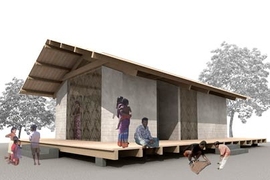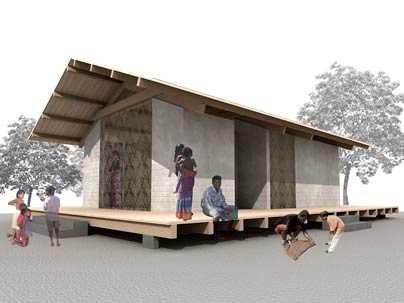Using high-tech engineering principles, an MIT/Harvard team has developed a low-tech solution to the problem of how to build homes in tsunami-prone areas.
The team recently produced an architectural model for a Sri Lankan house that essentially would allow a powerful ocean wave to go through the house, instead of knocking it flat.
The "Tsunami Safe(r) Houses," which will be built for about $1,200 each using materials available locally in Sri Lanka, will have four core columns made of concrete and rebar, each about 3 meters wide. Between these columns, homeowners can build walls of wood or bamboo to individualize the homes. Engineering simulations indicate that the design will help the core and foundation of the homes to withstand water or wind force over five times greater than a traditional concrete-block Sri Lankan home.
MIT's Buddhist chaplain, Tenzin Priyadarshi, and Carlo Ratti of MIT's Senseable City Laboratory (part of the urban studies department) initiated the project. They and the MIT Buddhist Foundation, Prajnopaya, hope to begin building the homes in Sri Lanka next month with money raised from donations. Tenzin will work with a board of directors representing several religious traditions and the Sri Bodhiraja Foundation in Sri Lanka. People of all faiths who lost homes in the 2004 tsunami are eligible for the homes.
The one- or two-bedroom, one-bath homes will be about 400 square feet and include an open floor plan for the kitchen and living areas. The homes will be built atop concrete blocks or wood 1 or 2 feet above ground so that high waters can flow underneath, making them more storm resistant. The architects also designed a community center based on similar type of construction to provide secular meeting places for the neighborhoods.
The new owners will be encouraged to take part in the construction of their homes.
Coordinators of the project are architects Ratti and Walter Nicolino of MIT, who are working with Luis Berrios, an MIT graduate student in architecture, and a team of graduate students from Harvard's Tsunami Design Initiative: Ellen Chen, Eric Ho, Nour Jallad, Rick Lam and Ying Zhou. The London-based engineering firm, Buro Happold, ran the simulations using a computer model the firm designed following its onsite, post-tsunami research.
Donations can be made at www.prajnopaya.org/found_donations.htm. For more information about the design, visit senseable.mit.edu/tsunami-prajnopaya.
A version of this article appeared in MIT Tech Talk on June 8, 2005 (download PDF).







